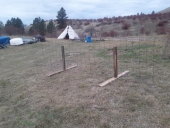Update on this....
Results inconclusive, but worth further study next time I get a round of caterpillars. Here's what I did and what I observed:
Trees infested by spongy moth caterpillars (small black hairy ones):
A - 2 x Apple tree in tree tube, ~5-6ft tall
B - 1 x Apple tree in tree tube, ~5-6ft tall
C - 3 x Apple tree in tree cage (no tube), 5-6 ft tall
D - 2 x newly planted Saskatoon bushes
E - 2 x newly planted Saskatoon bushes
Treatment 1 - Applied on A, C, D, E on Day 1
Treatment 2 - Applied on A, C, D on Day 2
Treatment 3 - Applied on all plants at the end of Day 3
Treatment 1 description:
1 gal water
3 TBSP Apple cider vinegar
4 TBSP molasses
3 tsp castille soap
Sprayed 3 gallons of this mix on trees thoroughly, top and bottom of leaves.
Treatment 2 description:
1 gal water
NO vinegar
8 TBSP molasses
3 tsp castille soap
Sprayed 3 gallons of this mix on trees thoroughly, top and bottom of leaves.
Treatment 3 description:
Plain water, sprayed at high speed with backpack sprayer to mechanically remove caterpillars from leaves
Observations:
BEFORE treatment:
-Bad caterpillar infestation on all plants. Caterpillars seemed reasonably active. Not all were actively eating leaves, but most were wriggling around and a significant number were clearly munching
24 hours after Treatment 1
-I noticed the caterpillars on sprayed apple trees A and C were more sluggish, didn't really look active. There were some that were actively munching on leaves, but most were just hanging out on the tree and seemed slow-moving. By contrast, the caterpillars on unsprayed tree B were more active and many were actively munching on leaves.
-Also, there were noticeably fewer caterpillars on trees C (the ones in tree cage), and I think slightly fewer on A (sprayed, in tube), but similar number of caterpillars on B (unsprayed in tube).
-Not much discernible difference on the Saskatoon bushes between sprayed and unsprayed - all the caterpillars looked kind of sluggish.
-However, I did notice a wasp munching on one of the sprayed caterpillars.
-I thought this was encouraging, so I proceeded with Treatment 2 immediately after making these observations
24 hours after Treatment 2 (NO Vinegar in this treatment)
-All caterpillars on all plants were noticeably more active than the previous day
-It seemed that the number of caterpillars was further reduced by a little bit on trees C (in tree cage)
-Discouraged by this, and needing to leave for 4 days, I administered Treatment 3 on all plants (plain water, sprayed from my backpack sprayer at high enough pressure to knock the caterpillars off the leaves)
4 days after Treatments
-I came back after 4 days and noticed some caterpillars were back on all trees, but much less than when we started and meaningfully less than the number before Treatment 3 (water spray).
-The caterpillars were bigger, and looked healthy and moderately active
-I noticed there were much fewer on trees C (cage) vs. A & B (tubes)
-So, since I had just finished putting up my deer fence, I decided to remove the tree tubes from all the apple trees. As I did so, I noticed that the lower leaves that were inside the tree tubes were much less caterpillar-infested than the ones on the upper leaves sticking out of the tree tube.
-I administered another water spray to knock caterpillars off, and called it a close of the experiment for now.
Emerging thoughts and hypotheses to test in future caterpillar attacks:
1. Wasps are my friend in the orchard. I want to encourage them to hunt here! I do have a lot of wasps nesting and living near my house, but they haven't quite fully made it out to the orchard yet. I guess time will sort that out.
2. The spray with a small amount of vinegar seemed much more effective than the spray with no vinegar. I want to test this more, but am a bit concerned about too much vinegar being bad for the plants
3. It seems that being in a tree tube somehow contributed to more caterpillars staying / coming back. I'm not sure why that is yet. I have guesses/ideas, but this is something to test out in future.
4. The molasses itself didn't seem to do much.
Questions for Permies:
1. Do you have experience with what is the concentration of vinegar (and what kind of vinegar) is non-toxic to plants, but toxic to caterpillars/pest insects?
2. Does this also have a negative effect on predator insects that are NOT directly sprayed (like wasps), or other beneficial insects like bees?
3. Does anyone have similar or contradictory experience with using molasses to control caterpillars / pest insects? Please share your experience!







